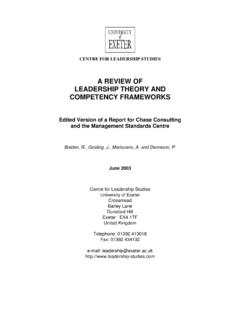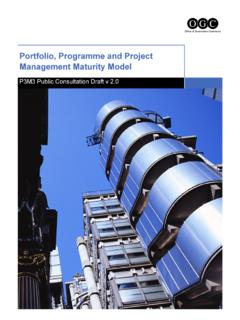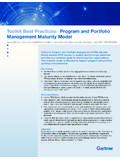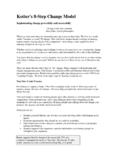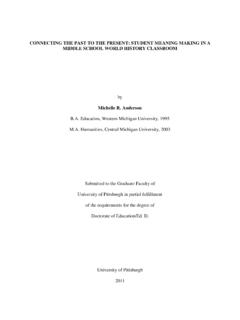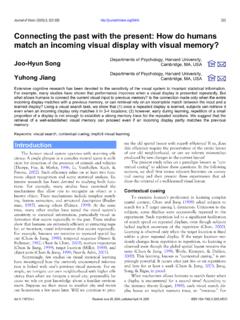Transcription of Defining Leadership: A Review of Past, Present, and Future ...
1 Defining leadership A Review of past , present , and Future ideas BY MATTHEW R. FAIRHOLM, DIRECTOR, leadership STUDIES AND DEVELOPMENT, CEMM MONOGRAPH SERIES MS02-02 THE GEORGE WASHINGTON UNIVERSITY CENTER FOR EXCELLENCE IN MUNICIPAL MANAGEMENT We encourage the distribution of these materials. However, no part of the contents may be reproduced without proper credit given to the author(s) and the GWU Center for Excellence in Municipal Management. 2002 by the Center for Excellence in Municipal Management Center for Excellence in Municipal Management s Research Program Since its inception, The George Washington University Center for Excellence in Municipal Management has focused on providing practitioner oriented research to support and expand its mission.
2 The Center s efforts have grown to include professional and academic research around such Center-related themes as government transformation, leadership and management, public-private partnerships, and leadership and executive education. The Center supports the School of Business and Public Management s mission by engaging in research and other schol-arly activities to advance leadership and management theory and practice and by providing management and professional expertise to government organizations. The Center s collection of working papers, academic and professional journal articles, book extracts, and thought pieces is designed to highlight current and Future trends in public management, enhance the Center s training and advisory services, encourage collaboration be-tween practitioners and academics, and provide another outlet for the creation and dissemi-nation of innovative ideas to SBPM students, alumni, faculty, and the general public.
3 The Center s research products can be found on our website: Center for Excellence in Municipal Management 2033 K Street, NW, Suite 240 Washington, DC 20052 202-994-5390, fax 202-994-5389 Defining leadership : A Review of past , present , and Future ideas The George Washington University Center for Excellence in Municipal Management Page i Table of Contents 1 I KNOW IT WHEN I SEE IT .. 1 HISTORICAL THREADS OF leadership 2 Trait Theory .. 2 Behavior Theory .. 5 Situational Theory .. 6 The leadership and Management 8 Values-based Transformational leadership : Beyond Reductionism .. 10 Values-based Transformational Values and THE MORALITY AND PHILOSOPHY OF leadership : WHAT GREENLEAF AND BURNS 13 EMERGING VIEWS AND DESCRIPTIONS OF 16 PERSPECTIVAL APPROACH TO UNDERSTANDING 17 FAIRHOLM S 18 leadership as (Scientific) Management.
4 19 Efficient, Predictable Use of Resources, and Individual Performance Issues, Organizing, Planning, and Direction ..20 Incentivization and Control ..21 leadership as Excellence Management .. 21 Continuous Process Improvement, Transforming Environments and Perceptions ..23 Listening Actively, Being Accessible, and Expressing Common Courtesy ..23 Motivation and Engaging Others in Problem leadership as a Values Displacement Activity .. 23 Developing Encouraging High Performance and Self-led Followers ..26 Setting, Enforcing, and Prioritizing Visioning and Communicating the Teaching, Coaching, and Trust Culture leadership .
5 27 Trust and Ensuring Cultures of Fostering and Maintaining Shared Cultures and Prioritizing Mutual Cultural Values and Team Building, Sharing Governance, and Group Performance ..29 Spiritual (Whole Soul) 30 Liberating the Best in People and a Concern for the Individual ..32 Developing Individual Wholeness While Building Community and Promoting Stewardship ..32 Fostering an Intelligent Organization, Setting Moral Standards, and Modeling a Service Inspiration ..33 SUMMARY OF LITERATURE Review .. 33 CONCLUSION .. 35 39 List of Tables Table 1: Historical Threads Of leadership Research And Theory.
6 36 Table 2: Fairholm's Perspectives On leadership Aligned With The Literature Review .. 37 Defining leadership : A Review of past , present , and Future ideas The George Washington University Center for Excellence in Municipal Management Page 1 Defining leadership : A Review of past , present , and Future ideas The George Washington University Center for Excellence in Municipal Management Page 1 Defining leadership : A Review of past , present , and Future ideas Matthew R. Fairholm, Introduction Defining leadership is a recent aca-demic activity, though the phenomenon of leadership has been ever present in human relations.
7 Stogdill reminds us that the word leader has origins back to the 1300s and the word leadership dates back to the 1800s. He reviewed over 3,000 studies directly related to leadership and suggested that there are almost as many different definitions of leadership as there are persons who have attempted to define the concept (Stogdill, 1974, p. 7). Bennis and Nanus (1985) found 350 definitions from thou-sands of studies. Rost (1991) found 221 definitions in 587 books and articles written from 1900 to 1990. These reviews of leadership studies and definitions have certainly not closed the book on leadership research.
8 In fact, many researchers lament the progress (or lack of progress) made in under-standing and Defining leadership . Ben-nis and Nanus (1985) conclude that [n]ever have so many labored so long to say so little (p. 4). Rost (1991) is even more indicting when he comments that these attempts to define leadership have been confusing, varied, disorgan-ized, idiosyncratic, muddled, and, ac-cording to conventional wisdom, quite unrewarding (p. 99). Yet these re-searchers, and many others, continue their work studying, Defining , identifying, and developing leadership . Yukl (1988) encourages this continued focus on leadership study.
9 Rather than cynically reflecting on past efforts, he suggests we draw upon the many exist-ing conceptualizations of leadership to give us a better, more thorough grasp of this necessarily elusive social phe-nomenon. His attempts to grasp lead-ership involve trying to integrate many of the previous leadership theories into an overarching supermodel of leadership . I Know It When I See It As players in the social and interper-sonal world, people have their own con-ceptions of leadership ; in other words, We know it when we see it. While many researchers recognize this, few study leadership with that notion in mind.
10 Researchers in the past have failed to account for the personal, more intimate idea of Defining leadership for oneself. They ignored the personal frames of reference, world views, and cultural constructs that call for each of us to answer for ourselves the question, What is leadership ? Recently, Fair-holm (1998a) has recognized this lack of focus and began work on understanding different leadership perspectives, or vir-tual realities, within which people oper-ate and measure the success or failure of leadership . Fairholm s model will be discussed later and will form the foundation for this re-search effort.
